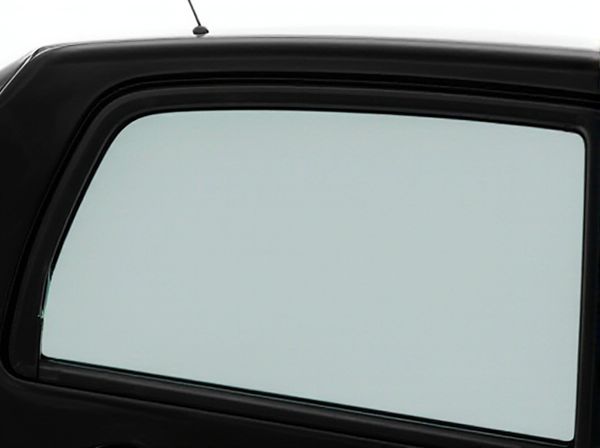
Photo illustration: Sliding vs Hinged Window
Sliding windows offer smooth horizontal operation and save space by gliding along tracks, making them ideal for areas with limited room. Hinged windows, which swing open either inward or outward, provide better ventilation and unobstructed views while allowing for easier cleaning. You should consider how much airflow, ease of access, and space efficiency are important factors in choosing between sliding or hinged windows.
Table of Comparison
| Feature | Sliding Window | Hinged Window |
|---|---|---|
| Operation | Slides horizontally along a track | Opens outward or inward on hinges |
| Space Efficiency | Does not protrude; good for tight spaces | Requires clearance for opening |
| Ventilation | Partial opening, limited airflow | Full opening allows maximum airflow |
| Ease of Cleaning | Accessible from inside; limited reach | Easily cleaned from inside or outside when open |
| Durability | Fewer moving parts, less wear | Hinges may require maintenance |
| Security | Generally secure with sliding locks | Potentially less secure; needs proper locking |
| Cost | Typically lower installation and material cost | Often higher due to mechanism and seal |
Introduction to Window Types: Sliding vs Hinged
Sliding windows operate by gliding horizontally along a track, offering space-saving functionality and smooth ventilation control. Hinged windows pivot outward or inward on side-mounted hinges, providing maximum airflow and easy cleaning access. Both types cater to different architectural styles and user preferences, influencing energy efficiency and maintenance requirements.
Key Differences Between Sliding and Hinged Windows
Sliding windows operate by gliding horizontally along a track, allowing smooth and space-efficient opening, making them ideal for areas with limited exterior space. Hinged windows swing open either inward or outward on side-mounted hinges, providing full ventilation control but requiring clearance for operation. The key differences include sliding windows offering easier maintenance and better suited for modern designs, while hinged windows provide enhanced emergency egress options and a classic aesthetic.
Space Efficiency: Which Window Suits Your Room?
Sliding windows maximize space efficiency by gliding horizontally along a track, requiring no interior or exterior clearance, making them ideal for rooms with limited space or adjacent outdoor areas. Hinged windows, such as casement or awning types, necessitate clearance for the window to swing open, which can reduce usable room space but offers better ventilation control and unobstructed views when open. Choosing between sliding and hinged windows depends on your room's available space, desired airflow, and aesthetic preferences to optimize both functionality and layout.
Ease of Operation and Accessibility
Sliding windows offer superior ease of operation with their smooth horizontal tracks, allowing effortless opening and closing, making them ideal for hard-to-reach areas. Hinged windows, such as casement or awning types, provide full ventilation and wider access but require more clearance space to swing open, potentially limiting accessibility in tight rooms. Both designs cater to different user needs; sliding windows excel in compact spaces, while hinged windows enhance accessibility where room allows full sash movement.
Energy Efficiency and Insulation Comparison
Sliding windows feature a simpler design with fewer moving parts, often resulting in slight air leakage around the tracks that can reduce energy efficiency compared to hinged windows. Hinged windows, especially casement types, create a tighter seal when closed, providing superior insulation and minimizing air infiltration. Energy efficiency ratings generally favor hinged windows due to their enhanced ability to prevent heat transfer and maintain indoor climate control.
Design Flexibility and Aesthetic Appeal
Sliding windows offer sleek, modern lines and maximize glass area for panoramic views, enhancing minimalist and contemporary architectural styles. Hinged windows provide diverse design options including casement, awning, or pivot styles, allowing greater customization in shape and opening mechanisms to suit traditional and eclectic aesthetics. Both window types can be tailored with various frame materials, finishes, and hardware to elevate aesthetic appeal and complement the overall design scheme.
Maintenance and Cleaning Considerations
Sliding windows require minimal maintenance due to their simple track system, but regular cleaning of the tracks is necessary to prevent debris buildup and ensure smooth operation. Hinged windows, especially casement types, offer better access to both sides of the glass for thorough cleaning but need routine lubrication of hinges to avoid rust and stiffness. Both window types benefit from periodic inspections to maintain seal integrity and prevent air or water leaks over time.
Security Features: Sliding vs Hinged Windows
Sliding windows feature interlocking sashes and multiple locking points, enhancing resistance to forced entry compared to standard designs. Hinged windows, often equipped with robust multi-point locks and reinforced hinges, offer superior security by tightly sealing the window frame and preventing prying. The choice between sliding and hinged windows depends on specific security requirements, with hinged windows generally providing stronger protection against break-ins.
Cost Implications and Budget Factors
Sliding windows generally offer a more budget-friendly option due to simpler installation and fewer moving parts, which reduces maintenance costs over time. Hinged windows, often made with more complex hardware and materials, tend to have higher upfront costs and may require professional installation, increasing overall expenses. Selecting between sliding and hinged windows depends on balancing initial investment with long-term durability and maintenance budget considerations.
Choosing the Right Window for Your Home
Sliding windows offer smooth operation and unobstructed views, ideal for modern homes seeking minimalist design and easy ventilation. Hinged windows, including casement and awning styles, provide superior airtightness and security, making them suitable for areas with strong winds or heavy rain. Selecting the right window depends on your climate, aesthetic preferences, and maintenance requirements to enhance comfort and energy efficiency.
 caratoz.com
caratoz.com